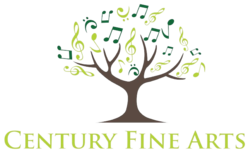Private Lessons vs Small Group Classes
by Sean Stone-Ashe
When it’s time to begin a child’s music education, there are many ways to navigate this new journey.
At Century Fine Arts, the most common format for learning is private lessons. However, CFA also offers engaging small-group classes for music learning as well.
In this article, I will discuss the key differences to expect between the private lesson and small-group learning opportunities.
Private Lessons
The biggest benefit to private lessons is that you receive the most individualized experience possible. Your teacher will maintain a specific set of goals just for you, and a plan of action to make you as successful as possible.
Additionally, the one-one-one nature of private lessons provides a space for a strong relationship between student and teacher. While music learning is always the primary goal of each lesson, the bonds of mentorship and friendship that can be forged throughout this long-term working relationship cannot be overlooked.
Lastly, private lessons are usually easier to schedule compared to a class. When considering the inflexible nature of many of our obligations, private lessons allow a bit of personal choice when trying to fit everything you can into your weekly schedule.

The biggest drawback of private lessons is that it is the most expensive possible option for learning music. However, you certainly get what you pay for, as the individual attention and personalized goals do make for an engaging and effective learning environment that a class setting cannot replicate.
Small Group Classes
One of the best benefits of learning in a small group setting is the ability to interact with peers. Not only is it fun to have more opportunities to make friendly connections, but it can also be motivating to see other people trying to do the same thing as you. It can also feel good to collaborate with peers working towards a final performance for the semester.
Another potential benefit is that group classes can be a lower-pressure environment for each individual member. If you are working on an ensemble piece, there may be multiple people learning the same part, meaning that each person does not have to be as strong. In private lessons, however, you may be expected to perform solo for an audience, which can be an intimidating prospect for some people.
Small-group classes are also a cost-effective way to provide a student with a positive musical experience. While I personally think you absolutely get what you pay for with private lessons, it may feel better to use small group classes as a lower-commitment way to get a student started on their musical journey.
There are certainly some drawbacks to the small-group setting. For instance, there will be a pre-determined meeting time which simply may not work for your busy schedule.
Additionally, the classes are not as focused on each student’s individual needs, and therefore you should expect that eventually group classes will not provide the opportunities and focus that an advancing music student may require.

If you are trying to decide on the right way to get started with a child’s music education, there are no wrong answers. It never hurts to try a free trial lesson at Century Fine Arts to see if you feel like that learning
environment is right. But, my best advice is to try to ask as many questions as possible, and just try something out for a semester to see if it feels good.
I can say that I have had students who have started out in classes and eventually find that private lessons are what they need, while I have also had students who have done the opposite and found that a group class was more engaging.
© 2024 Century Fine Arts



